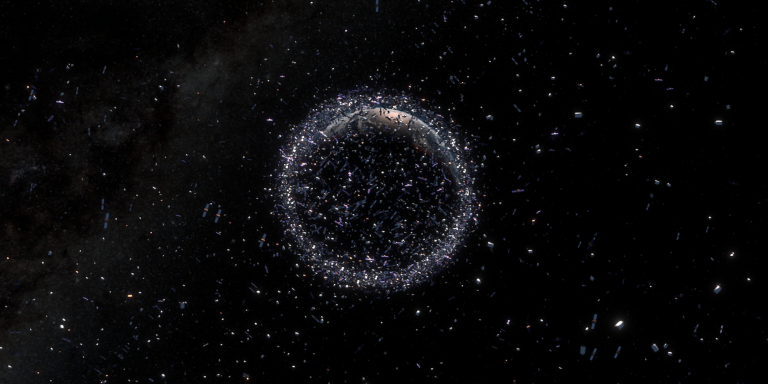
Sputnik, in 1957, opened the way to the conquest of space. Since then, many satellites have been launched, either for scientific research like the ISS or for commercial purposes, like Quantum. Some have exploded, collided with others: objects ranging from the last stages of launchers to simple bolts are currently in orbit. The European Space Agency’s (ESA) Space Debris Office at ESOC in Darmstadt, Germany, has estimated that there are a million of those measuring at least 1 cm, and that a collision with active satellites could not only cause great damage to them but also their destruction. ESA is relying on AI to prevent these risks.
The number of debris in low earth orbit, whether caused by collisions, explosions or simply abandoned at the end of a mission, is increasing and represents a significant risk for active satellites.
The ISS, the International Space Station, travels at an altitude of 400 km and at 28,800 km/h and circles the earth in 92 minutes. The risk of collision with debris in this low orbit is important, and since its launch in 1998, it has had to carry out about thirty avoidance maneuvers, which have been more frequent in recent years.
In particular, it had to modify its trajectory in November 2021 to avoid the collision with debris generated by a test launch of Russian anti-satellite missile, which allowed the destruction of Kosmos-1408, launched in 1982, become useless, and redid a similar maneuver, for the same reason, last June 16.
The destruction of Kosmos-1408 gave birth to about 1 500 debris. On May 16, the Sentinel-1A satellite, developed by ESA in the framework of the European Copernicus program, had to deviate its trajectory to avoid one of them.
NASA had stated in November 2021:
“All countries have a responsibility to prevent the deliberate creation of space debris from ASATs and to foster a safe and sustainable space environment.”
For ESA, progress has been made in recent years toward a sustainable space environment. For example, many of the satellite launchers in low Earth orbit are being disposed of responsibly as are more and more satellites at the end of their missions, the problem is getting rid of all the rest, including those already there.
ESOC’s Debris Office
ESA’s European Space Operations Centre (ESOC) is located in Darmstadt, Germany. One of its functions is the Debris Office, which is responsible for providing operational services to ongoing and planned missions within ESA and to third parties.
These services include:
- on-orbit collision avoidance (predictions, prediction refinements, and recommendations on avoidance maneuvers)
- re-entry prediction and risk assessment (re-entry time and location prediction, spacecraft disintegration and disappearance prediction, and ground risk assessment)
- the maintenance of the information of knowledge of the space situation on all the traceable objects in the DISCOS database (Database and information system characterizing the objects in space).
In its April 2022 report, it reiterates that the most effective way to prevent debris growth is through strict adherence to the IADC (Inter-Agency Space Debris Coordination Committee) Space Debris Mitigation Guidelines: avoiding on-orbit collisions, safely disposing of spacecraft at the end of their mission, and most importantly, preventing the risk of explosions.
Holger Krag, head of the Debris Office, states:
“Explosions in orbit are the largest current contributor to the space debris problem; they are caused by leftover energy – fuel and batteries – on board satellites or launch vehicles. Despite the measures that have been in place for years to prevent these explosions, we are not seeing any slowdown in the frequency of these events. The trend of taking action to deorbit spacecraft at the end of a mission is improving, but slowly.”
Securing space with AI
ESA has invited the global AI community to participate in the development of a system that can autonomously avoid space debris or at least reduce the burden on experts. Since 2021, AI algorithms have been alerting teams when one of their satellites might collide with another object in orbit.
Holger Krag stated at the time:
“Every collision avoidance maneuver is a nuisance. Not only because of the fuel consumption, but also because of the preparation involved. We have to book ground station passes, which costs money, sometimes we even have to disable scientific data acquisition. We have to have an expert team available 24 hours a day.”
He added:
“So far, we have automated everything that would require an expert brain to be awake 24/7 to respond and track collision alerts. Making the ultimate decision whether or not to perform the avoidance maneuver is the most complex part to automate and we hope to find a solution to this problem in the next few years.”
However, space debris catalogs are not comprehensive enough to train AI algorithms: small debris is not listed as well as military satellites…
Cleaning the Earth’s orbit: ClearSpace-1
Eliminating debris could be a more effective solution than trying to avoid it. In 2013, the Clean Space office was created, its mission being “to secure the future of space activities by protecting the environment on Earth and in space.” The team’s ambition is to clean Earth’s orbit of debris, and in 2020, ESA signed an 86 million euro contract with Swiss start-up ClearSpace, created in 2018 and based at EPFL’s Innovation Park, for the purchase of a unique service: the first removal of space debris from orbit.
ClearSpace-1’s mission is to recover the upper stage of an ESA Vega rocket launched in 2013. It will enter orbit 500 km above Earth, a little lower than the debris, to test its proper functioning. Then, it will approach it, will seize it thanks to its four robotic arms and will disintegrate with it while going down in the Earth atmosphere. The mission is planned for 2025-2026.
Translated from Comment l’IA peut-elle contribuer à la gestion des débris spatiaux ?









